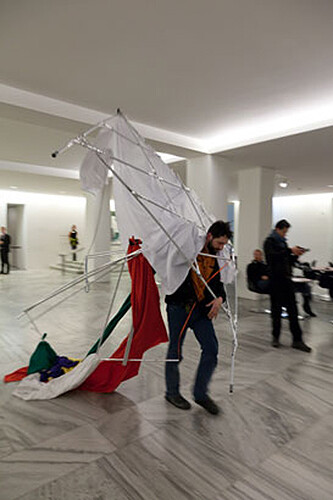A few weeks ago I found myself in the winter chill outside Kunsthaus Zurich, watching a trance-like Yorgos Sapountzis methodically pace the platz as he dragged a tattered bouquet of bright, flag-like fabrics attached to poles behind him. After herding the audience about like an expert cowpoke, he and his two festively dressed female attendants (looking ready for a freak folk concert in more pastoral pastures) disappeared behind Rodin’s imposing Gate of Hell, which famously fronts the Kunsthaus. Suddenly a racket of noise—amateur banging, thunderish clapping—began. The Greek artist reappeared, stormed into the crowd, then just as quickly disappeared into traffic. A tram rolled past, some polizei nosed about, and the performance was over.
Conjuring both a vague religious processional and a casual neo-pagan ritual, Sapountzis’s performance had begun inside, near a huge Hodler frieze depicting a battle scene. As the Berlin-based artist swirled up and down a flight of marble stairs wrapped in brilliantly colored textiles, a film of public statuary gelled with crass, fluorescent hues was projected against an ad-hoc structure of more bright cloth tied to thin scaffolding, over which a propulsive electronic soundtrack drummed on. With its strange admixture of reticence and inspiration, the performance was a perfect storm of Sapountzis’s regular means and mores and concerns. His work is preoccupied with the pale classical monuments and public sculpture at which his homeland famously excelled and exported, and which he now activates and complicates and, yes, colors with the intrusion of his physical body and that of his audience, with his riotous yet elegant films and photographs, and with the counterpoint of his own vivid, provisional structures.
The Kunsthaus performance, billed as “The Door The Gates,” was held in honor of Sapountzis’s first Swiss solo exhibition mounted at Freymond Guth Fine Arts across town. Entitled “Sculptures and Mirrors,” the show also illustrated the artist’s many approaches, featuring fabric-and-frame structures, a projected film, and a selection of small, inkjet-print images called “Post Canonical Forms.” This last gorgeous series was familiar to me, but that familiarity did not dull its beauty or strange excellence. Taken at the Museum of Cycladic Art in Athens in 2009, when Sapountzis was nominated for the DESTE Prize, the unique images have a bit of geometric smoke-and-mirrors about them—recalling Eileen Quinlan and Walead Beshty’s photographic experiments—though they are fairly straightforward. Out of velvety brown grounds appear small Cycladic figures, pale and lucid as moons, encased in glass vitrines, against which are reflected the brightly colored fabric tents that Sapountzis installed in the museum. The myriad reflections, which contrast the figures’ marble contours with the sumptuously hued and draped textiles, turn each image into a kaleidoscopic historical diorama, in which Neolithic art, classicism, and modernism rub small, perfectly shaped shoulders.
In the same gallery, a sculpture of brightly colored planes—painted newspaper strung across a broken bicycle frame—jutted off one wall like a wing. Nearby, a towering, square-ish structure of cloth-enveloped aluminum tubes propped up on jars of preserved fruits recalled the silhouette of Rodin’s Gate, were the earlier sculptor’s human figures replaced with bits of bright, twisted textiles. If the two works had a graphic spark, their dissembling abjectness also felt familiar and a bit uninspired. Far more effective and convincing was another pole-and-cloth structure in the room next door. Against its scaffolding-like walls, a film documenting all angles of Jakob Brüllmann’s 1911 public sculpture of a rearing bull and figure was projected across it. Sapountzis washed his film in a crayola box of neon colors, then added a pulsing soundtrack by the artist’s regular sonic collaborator Ovind Torvund, which completed the work with its ironic evocation of military parades and a weirdly pleasurable call to arms.
Contemporary artists playing provisional materials and corporeal fragility against the sculptural purity and architectural solidity of classicism and modernism are not unique. Yet Sapountzis manages to set himself apart from the historicizing pack. His poetic reliance on those strange colored fabrics—freak flags of some other order—and silvery scaffolding, turn these materials into archetypes that might replace the older archetypes (marble monuments), while evoking myths and histories both ancient and modern. His use of color and sound to stain his films of public sculpture, meanwhile, invest the iconic monuments with new feeling and meaning—a kind of playfully ironic allegiance and grandeur—which in turn references the old feeling and meaning (grand patriotism sans irony) they were originally meant to conjure. A hall of mirrors, indeed. What’s interesting to note is that Sapountzis’s work is at its most suggestive and convincing when it is girded by multiple approaches (photography, film, performance); his autonomous objects and structures, in contrast, without the help of film or performance, can feel flat and uninspired. This is notable because sovereign Western sculpture is his main subject—well, that, and how we might make sense of it today. Which perhaps places his very “failure” to make effective autonomous sculptures of his own in a new light.






